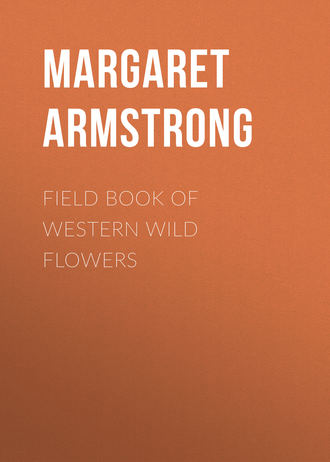 полная версия
полная версияField Book of Western Wild Flowers
Ragwort
Senècio perpléxus var. díspar
Yellow
Spring, summer
Utah, Idaho
A conspicuous plant and quite handsome, though its flowers are rather untidy-looking, for, like many other Senecios, the rays do not come out evenly. It is about two feet high, with a stout, hollow, ridged stem, sparsely woolly, and dark green, thickish leaves, with shallow and uneven teeth and covered with sparse, fine, white woolly hairs, as if partially rubbed off. The flowers are over an inch across, with bright yellow rays, curling back in fading, an orange center, fading to brown, and the bracts of the involucre tipped with black. This grows in moist rich soil, in mountain valleys.
Creek Senecio
Senècio Douglásii
Yellow
Spring, summer, autumn
Southwest
A handsome bush, about three feet high, covered with many flowers, on slender flower-stalks, sticking up out of a mass of rather delicate foliage, which is often covered with white cottony wool. The flowers are an inch and three-quarters across, with bright light yellow, rather untidy rays and yellow centers. This grows in dry stream beds and on warm slopes in the foothills.
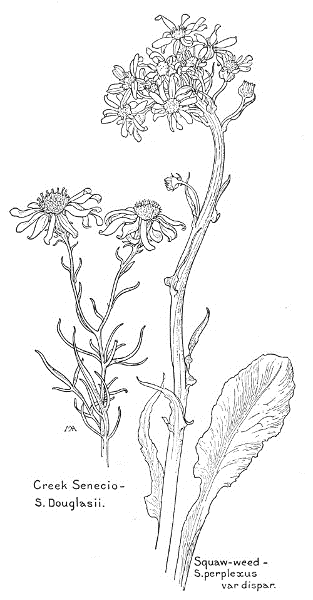
Creek Senecio – S. Douglasii.
Squaw-weed – S. perplexus var. dispar.

Senècio Lémmoni
Yellow
Spring
Arizona
This is quite effective, with attractive flowers and foliage, growing among rocks on hillsides and forming large clumps over a foot high. The stems are slender and often much bent, the leaves are dark green and thin in texture with toothed edges, rolled back, and the numerous flowers are an inch across, with bright yellow rays and deep yellow centers. This plant blossoms both as an annual and as a perennial.
White Squaw-weed
Senècio cordàtus
White
Summer
Northwest
A rather handsome plant, with a stout stem, about two feet tall; the upper leaves more or less downy and the root-leaves rather thick and soft, covered with whitish hairs on the under side. The flower-heads are about three-quarters of an inch across, with a fuzzy, pale yellow center and white rays. This grows in open woods, at rather high altitudes.
Senècio Riddéllii
YellowSpring, winter
Arizona
A rather showy plant, from six inches to two feet tall, blossoming both as an annual and as a biennial, after which it dies. The whole plant is smooth and the foliage is green or bluish-green, rather delicate and pretty. The flowers are an inch to an inch and a half across and they begin to appear in winter when there is little else to brighten the desert mesas. This plant is abundant in valley lands, though it has a wide range.
S. multilobàtus
Yellow
Summer
Ariz., Utah, etc.
A rather pretty plant, about a foot tall, with a few small leaves on the slightly woolly stem, but most of them in a rosette at the base. They are smooth, thickish and slightly stiff, about an inch and a half long, and neatly cut into small, toothed lobes. The few flowers are in a loose cluster at the top of the stem and have heads about three-quarters of an inch across, with pale yellow rays and brighter yellow centers. This grows at the Grand Canyon and on the dry plains of Utah and Colorado, at altitudes of about seven thousand feet.
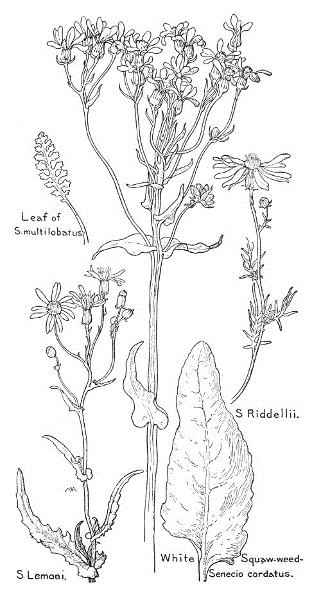
Leaf of S. multilobatus.
S. Riddellii.
S. Lemmoni.
White Squaw-weed – Senecio cordatus.
African Senecio
Senècio élegans
White and mauve
Spring
California
A handsome plant, which is noticeable on account of its unusual coloring. The stout, smooth stem is two or three feet tall, with smooth, slightly thickish leaves, the margins rolled back, a very peculiar shade of light bright yellowish-green. The handsome flowers are an inch and three-eighths across, with bright deep yellow centers and white rays shading to mauve at the tips, and form a large flat-topped cluster. This is a native of Africa and is not yet common in this country, but grows on the sand dunes near San Francisco.
There are many kinds of Baccharis, all American, chiefly shrubs.
Groundsel-tree
Chaparral Broom
Báccharis pilulàris
Whitish, yellowish
Autumn
Cal., Oreg., Wash.
A branching evergreen shrub, from two to five feet high, with smooth dark green, leathery leaves, an inch or less long, rather wedge-shaped, usually coarsely toothed. The flower-heads are very small, without rays, and are crowded at the ends of the twigs. Some plants have only staminate flowers and some only pistillate ones, and the effect of the two sorts is very different, for the staminate flowers are ugly, but the pistillate ones are provided with quantities of long, white, silky pappus, giving a beautiful, snowy appearance to the shrub. This is very variable, being a fine shrub in favorable situations, and is common along the coast on the sand dunes, on low hills and on high mountain slopes.
There are a great many kinds of Aster, most abundant in North America, difficult to distinguish, the flowers never yellow. Though there are some fine ones in the West, they are not so numerous or so handsome as in the East.
Aster
Aster Chamissónis
Purple
Summer, autumn
Cal., Oreg.
This is one of the commonest kinds and is quite handsome, from two to five feet high, with leafy, branching stems and alternate, lance-shaped leaves, from two to five inches long, usually toothless, without leaf-stalks. The many flowers are an inch or more across, with yellow centers and white, violet, or purple rays, the bracts of the involucre in several rows, with short and rounded tips. This is rather variable. A. radulìnus, Broad-leaf Aster, has stiff, rough leaves, sharply toothed towards the broad tips, and usually many flowers, an inch or so across, with whitish rays. This is rather common on dry hills in California and Oregon, blooming in summer and autumn. A. Andersóni, of Yosemite, has toothless, grasslike root-leaves and one beautiful flower, an inch across, with purple rays.
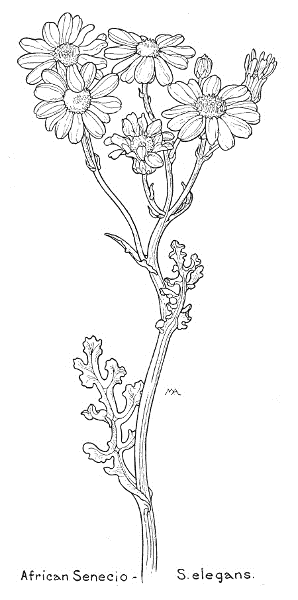
African Senecio – S. elegans.
CHICORY FAMILY. Cicoriaceae
A large family, of wide geographic distribution, resembling the Sunflower Family and by some authors included in it. They are herbs, rarely trees, almost always with milky, acrid, or bitter juice; the leaves alternate or from the root; the flowers small and crowded in heads, with involucres, the bracts in one or several rows; the receptacle flat or flattish, sometimes naked or smooth, sometimes scaly, pitted or honeycombed; the flowers all perfect; the calyx-tube without pappus, or with pappus of scales or bristles, sometimes feathery; the corollas not of two sorts, like those of the Sunflower Family, but all with a strap-shaped border, usually five-toothed, and a short or long tube; the anthers united into a tube around the style, which is very slender and two-cleft or two-lobed; the ovary one-celled and inferior, developing into an akene.
There are several kinds of Ptiloria, of western and central North America.
Flowering-straw
Ptilòria pauciflòra (Stephanomeria runcinata)
Pink
Spring
West, etc.
In the desert this is a very strange-looking, pale plant, forming a scanty, straggling bush, about two feet high, with slender, brittle, gray stems, most of the leaves reduced to mere scales, and delicate, pale pinkish-lilac flowers, less than half an inch long. This grows on the plains, as far east as Texas, and is not always so leafless as in the picture, which is that of a desert plant, but has some coarsely-toothed leaves.
Desert Pink
Ptilòria Wrìghtii (Stephanomeria)
Pink
Summer
Ariz., New Mex.
Much like the last, but not a queer-looking plant, with pale green foliage and larger, prettier flowers, three-quarters of an inch long, giving the effect of tiny, pale pink carnations. This grows at the Grand Canyon.
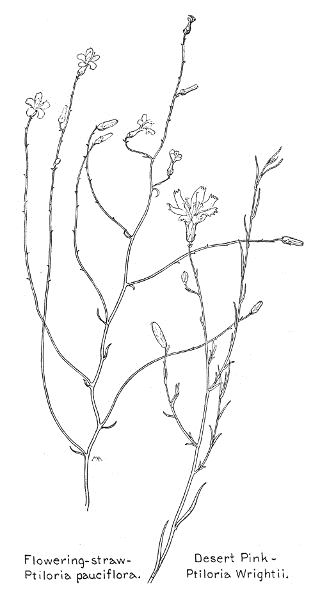
Flowering-straw – Ptiloria pauciflora.
Desert Pink – Ptiloria Wrightii.
There are a good many kinds of Agoseris, natives of western and southern North America and of southern South America.
Goat Chicory, Large-flowered Agoseris
Agóseris glàuca
Yellow
Spring
Utah, Ida., Wash., etc.
A pretty perennial plant, about fourteen inches tall, with a slender, slightly woolly flower-stem, springing from a pretty cluster of smooth bluish-green leaves, sometimes toothless, and bearing a handsome bright yellow flower, from one to two inches across, the involucre often covered with white wool. This grows on dry slopes, as far east as Colorado.
There are a good many kinds of Malacothrix, natives of the western and southwestern United States.
Malácothrix glabràta
Yellow
Spring
Southwest, Nev., Utah
A very attractive plant, with several flower-stalks, from six inches to a foot tall, springing from a pretty feathery tuft of bright green root-leaves, cut into almost threadlike divisions and often tinged with deep red. The handsome flowers are nearly two inches across, clear very pale yellow, shading to brighter color towards the middle. This is common on open plains in southern California, where it passes almost gradually into M. Califórnica, which is similar, but conspicuously woolly when young, covered with very long, soft hairs.
Snake's Head
Malácothrix Còulteri
White
Spring
California
A smooth plant, with a "bloom," from five to sixteen inches high, often branching from the base, the leaves cut into wavy lobes, with no leaf-stalk. The handsome flowers are about an inch across, white, turning pink in fading, the involucres with shining, papery, green and white bracts. This is one of the most conspicuous annuals in the San Joaquin Valley. M. saxàtilis, the Cliff Aster, is a handsome perennial, common in southern California and often growing on sea-cliffs. It has a leafy branching stem, from one to four feet high, the leaves toothless, or cut into slender divisions, and often quite fleshy, and many pretty flowers at the ends of the branches. They are each about an inch across, white, changing to pink or lilac, with an involucre of many narrow bracts, running down the flower-stalk. This is common in southern California, blooming in summer and autumn.
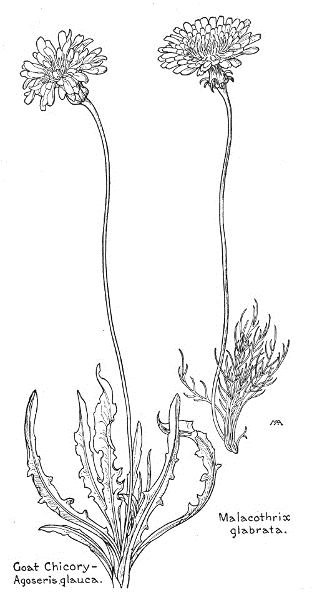
Malacothrix glabrata.
Goat Chicory – Agoserìs glauca.
Desert Dandelion
Malácothrix Féndleri
Yellow
Spring
Arizona
An attractive little desert plant, about five inches tall, with stiffish, pale bluish-green leaves, forming a rosette, and pretty, very pale yellow flowers, nearly an inch across, like a delicate sort of Dandelion. It is a near relation of the common Dandelion and blooms early in the spring.
Salsify, Oyster Plant
Tragopògon porrifòlius
Purple
Spring, summer
West, etc.
This is the common Salsify, the root of which is used as a vegetable. It is naturalized from Europe and is now quite common in the West as a "stray" and also in the East. It has a smooth, stout, hollow stem, from two to over four feet tall, rather dark green, smooth leaves, clasping at base, and handsome flowers from two to four inches across, which are a very peculiar shade of reddish-purple, not usually seen in flowers. They open early in the morning, closing by midday and fading almost immediately when picked, and may be seen growing along the edges of fields and just outside garden fences where they are often quite conspicuous. This plant has many common names, such as Jerusalem Star, Nap-at-noon, and Vegetable Oyster.
Desert Chicory
Nemosèris Neo-Mexicàna (Rafinesquia)
White
Spring
Ariz., New Mex.
A straggling desert plant, from a few inches to a foot and a half high, with smooth branching stems and smooth, very pale bluish-green leaves, rather thick in texture. The pretty flowers are from one to two inches across, white, tinged with pink or cream-color and a little yellow in the middle, often striped with magenta on the outside, and the bracts of the involucre tinged with pink and bordered with white. N. Califórnica is a branching plant, from one to five feet tall, with a stout stem and smooth oblong leaves, lobed, toothed, or almost toothless, and quite pretty flowers at the ends of the branches. They are about an inch across, white, often tinged with magenta on the outside. This grows in California and Oregon, usually in shady or moist places.
There are several kinds of Cichorium, natives of the Old World. The name is from the Arabic.
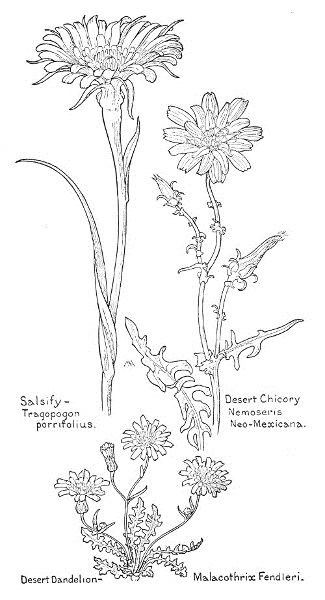
Salsify – Tragopogon porrifolius.
Desert Chicory – Nemoseris Neo-Mexicana.
Desert Dandelion – Malacothrix Fendleri.
Chicory, Blue Sailors
Cichòrium Íntybus
Blue
Summer, autumn
Northwest, etc.
This is a straggling plant, from one to three feet tall, a perennial, with a long, deep tap-root, stiff, branching stems, and leaves irregularly slashed into toothed lobes and chiefly from the root. The pretty flowers are from an inch to an inch and a half across, much like those of Desert Chicory, but very brilliant blue, occasionally white. This plant has escaped from cultivation and is now very common in waste places and along roadsides in the East and often found in the West. The ground-up root is used as a substitute for coffee. There is a picture in Mathews' Field Book.
There are several kinds of Microseris, rather difficult to distinguish.
Silver-puffs
Microsèris linearifòlia
Yellow
Spring
Southwest, Nev.
This is about a foot tall, with smooth, hollow flower-stems, smooth leaves, and rather small yellow flowers, not particularly pretty. The "gone-to-seed" flower-heads are, however, very conspicuous, for they are nearly an inch and a half across, and each seed is tipped by a little silvery paper star, the effect before the wind carries them away being exceedingly pretty, a good deal like a Dandelion puff. This grows in the Grand Canyon on the plateau.
There are many kinds of Sonchus, natives of the Old World.
Sow Thistle
Sónchus oleràceus
YellowAll seasons
West, etc.
A common weed, from Europe, found across the continent, coarse but decorative in form, with a stout leafy stem, from one to four feet tall, and smooth leaves, with some soft prickles on the edges, the upper ones clasping the stem and the lower ones with leaf-stalks. The pale yellow flowers are three-quarters of an inch or more across.
There are several kinds of Taraxacum, natives of the northern hemisphere and southern South America.
Dandelion
Taráxacum Taráxacum
Yellow
All seasons
U. S., etc.
This is a weed in all civilized parts of the world, growing in meadows, fields, and waste places. It has a thick, deep, bitter root, a tuft of root-leaves, slashed into toothed lobes, and several hollow flower-stalks, from two to eighteen inches tall, each bearing a single, handsome, bright yellow flower, from one to two inches across, which is succeeded by a beautiful silvery seed puff. This plant has many common names, such as Blow-ball, Monk's-head, Lion's-tooth, etc.
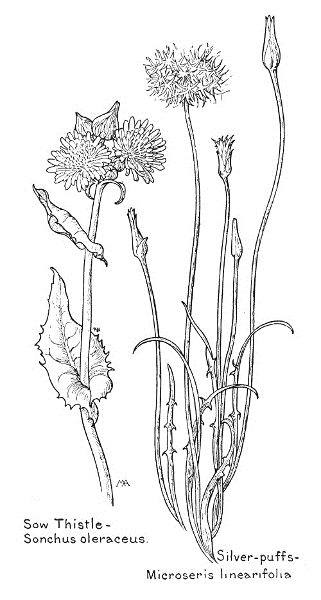
Sow Thistle – Sonchus oleraceus.
Silver-puffs – Microseris linearifolia.

There are a great many kinds of Crepis, natives of the northern hemisphere.
Gray Hawksbeard
Crèpis occidentàlis
Yellow
Spring, summer
West, etc.
This is a pretty plant, for the gray-green foliage sets off the yellow flowers. It is from six to eighteen inches high, more or less hairy or downy all over, with one or several, stout, branching, leafy stems, and thickish leaves, variously cut, mostly jagged like Dandelion leaves, with crisp margins, dark bluish-green in color and often covered on the under side with obscure white down, the root-leaves narrowed to leaf-stalks at the base. The flower-heads are about an inch across, with bright yellow rays, the involucre sprinkled with short, dark hairs. This grows on dry plains, as far east as Colorado.
Smooth Hawksbeard
Crèpis vìrens
Yellow
Summer
Cal., Oreg., etc.
This is a weed from Europe, growing in fields and waste places, in the East and on the Pacific Coast. It is a smooth plant, from one to two feet tall, with green leaves the shape of Dandelion leaves, chiefly in a bunch at the root. The many, small, yellow flowers, each about a quarter of an inch long, are in a loose cluster at the top of the stem. This is very variable.
Hawksbeard
Crèpis acuminàta
Yellow
Spring, summer
West, except Ariz.
A handsome and conspicuous plant, often forming large clumps, from one to three feet tall, with dull green, downy, rather leathery leaves, irregularly slashed and cut, and large clusters of light bright yellow flowers, each about three-quarters of an inch across. This grows on hillsides and on high dry mesas.

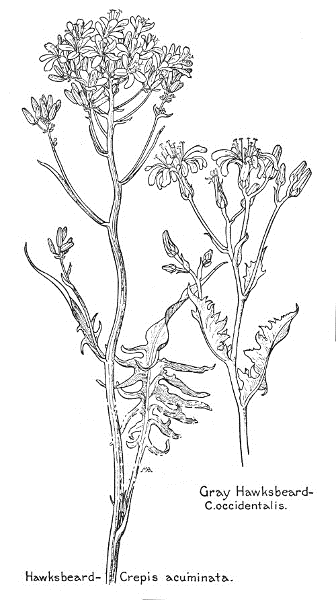
Gray Hawksbeard – C. occidentalis.
Hawksbeard – Crepis acuminata.

